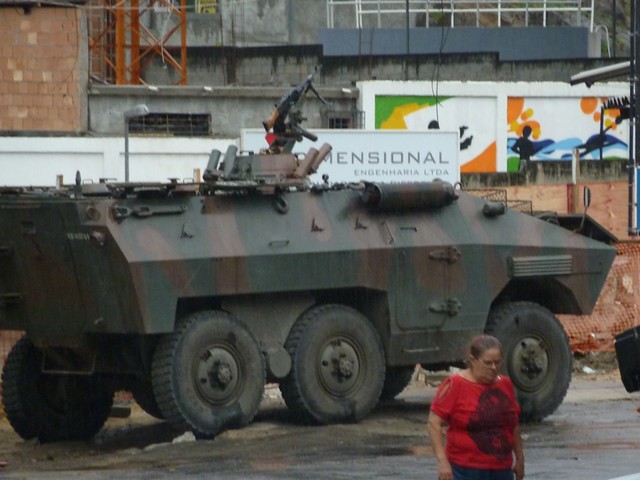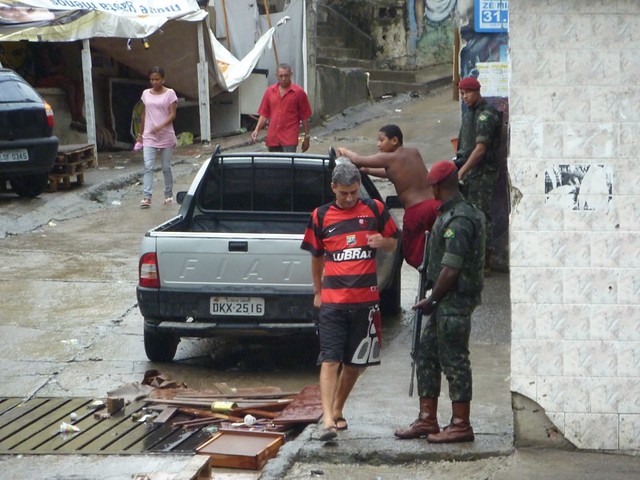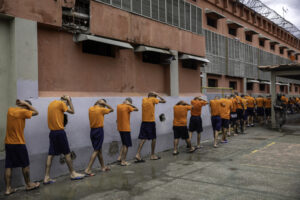Just before the holidays I accompanied WOLA colleagues on a week-long research trip to Brazil. While In Rio de Janeiro, I saw a scenario that’s starting to look very familiar around Latin America, and that may recur elsewhere in 2011.
It goes something like this:
-
Decades of government neglect effectively cede a piece of territory, and its population, to violent groups. This neglected territory could be a discrete urban neighborhood; it could be a vast rural region. The violent groups – whether insurgents, pro-government militias, mafias or gangs – recruit unoccupied youth and fund themselves by drug trafficking, extortion and kidnapping. The illegal groups corrupt and penetrate the very government institutions that are supposed to confront them: the security forces, the judicial system, local and sometimes national government.
-
The violence and illegality worsen, eventually becoming so intolerable that they affect daily life in wealthier, more central territories – if not national security as a whole.
-
The government responds by sending in large numbers of security forces, including army troops, to clear the violent groups from the neglected zone and hunt down their members.
-
Past experience or current frustrations make clear that a military/police occupation won’t be enough. Instead, officials present an innovative-looking, sequenced and coordinated “whole of government” plan. The idea is to bring in more trustworthy police, have civilian government agencies provide basic services, and integrate the zone’s residents as full citizens who are no longer excluded from national life.
-
At the end, the plan calls for the security forces to withdraw to normal levels, leaving behind a functioning civilian state, a legal economy and an engaged citizenry.
If you follow Latin America, you’ve seen this scenario playing out, with varying degrees of success, in Ciudad Juárez (the “Todos Somos Juárez” program) and some other Mexican border cities; in the slums ringing Medellín, Colombia (“Operación Orión” and its aftermath); and in rural Colombian zones like La Macarena, where an ambitious “Consolidation” program is now completing its fourth year. If you follow Afghanistan, this narrative also probably applies to territories like Marjah or Kandahar since the Obama administration increased troop levels a year ago.
This list now includes Rio de Janeiro, a mega-city that will host some of the soccer World Cup in 2014 and the Olympics in 2016. A “Favela Pacification Program” begun at the end of 2008 is now accelerating as Rio seeks to regain control of pockets of statelessness – decades-old shantytowns and slums called favelas, dispersed throughout the city.
Impoverished, violent, poorly governed neighborhoods are common in Latin America, where rapid urbanization began in the second half of the twentieth century. In most of the region’s cities, though, slums concentrate on the outskirts. The poor neighborhoods blanketing the hillsides around downtown Medellín are a classic example.
Rio de Janeiro is different. A legacy of freed slaves relegated to what was then the city’s worst land – hilltops and swamps – Rio’s shantytowns are scattered throughout the city’s geography, including alongside some of its most exclusive neighborhoods. For generations, the favelas were tolerated but ignored. City government made little or no effort to provide services like electricity or water, which are pirated, or even trash collection. Notoriously corrupt police provided little or no protection, if they were present at all.
In last 20 years, these pockets of urban lawlessness were taken over by violent drug-trafficking gangs who carry weapons and deal drugs openly, with a cocaine-on-display brazenness not equaled in Colombian or Mexican cities. Today, most of the violent competition for control of the drug trade takes place between three gangs: the “Red Commandos” (Comando Vermelho), the “Friends of Friends” (Amigos dos Amigos), and the “Pure Third Command” (Terceiro Comando Puro). In addition, some favelas have seen the drug gangs displaced by “militias” – vigilante groups usually led by off-duty police – who rival the gangs in brutality and corruption.
Rio’s Military Police have been part of the problem. (Despite their name, the Military Police are no longer a part of Brazil’s armed forces, as they were during the country’s 1964-1985 dictatorshop. Today, Military Police forces are constabularies subordinated to state governments, but with a military-style organization and subject to the military justice system.) With “resisting arrest” the most frequent pretext, the Rio and Sao Paulo police kill over 1,000 people each year, making them probably the most lethal police forces in the world. Between their reputation for brutality and their reputation for corruption – including collusion with the drug-trafficking gangs – the Military Police are widely distrusted, if not hated, in the favelas.
In December 2008, Rio’s state and city governments under Governor Sergio Cabral and Mayor Eduardo Paes (whose PMDB party is part of Brazil’s ruling coalition) embarked on a new strategy, the Favela Pacification Program. Under the program, the Rio Military Police’s elite unit (the Police Special Operations Battalion or BOPE, featured in the “Elite Squad” movies) sweeps into a favela, chasing out – or chasing underground – the gangs. This operation often includes intense urban combat.
Immediately afterward, the BOPE are meant to give way to government officials offering social services and a brand-new police force, the Pacification Police Units or UPP.
The UPP is a key piece of this puzzle. Though part of the Military Police, it is a force-within-a-force being created from scratch. It recruits only brand-new police, untainted by association with the old, troubled force, and prefers college graduates. Recruits to the new force receive training with a large component of human rights and community policing skills. Afterward, UPP members are closely monitored for signs of corruption or abusive behavior.
A confidential 2009 WikiLeaks cable from the U.S. Consulate in Rio (worth a read) explains further.
UPP commander Colonel Jose Carvalho – a former United Nations Peacekeeping Commander – told us on August 25 that only new police academy recruits are selected into the UPP program. “We need fresh, strong minds, not a Rambo,” Carvalho stated. “The older generation of cops is more oriented to kicking down doors and shooting people.”
 |
|
Armored personnel carrier at an entrance to the Complexo de Alemão favela.
|
The UPP received glowing praise in an October 2010 New York Times article about its operations in the notorious City of God favela, one of the f
irst to be occupied in late 2008.
Even with violent challenges ahead, many Rio residents are rooting for the program. Dilma Rousseff, the leading candidate to be Brazil’s next president, has proposed expanding the model to other cities. Millions of dollars in donations from companies like Coca-Cola and a billionaire businessman, Eike Batista, are also pouring in, paying for things like police equipment.
With 1,000-1,500 members and presence in a few dozen favelas – most of them small communities near some of the wealthiest tourist beaches – the UPP is still a small force, though recruitment and training are accelerating. The goal is to arrive at about 12,000 UPPs, present in 160 communities, by 2014, according to Rio state Public Security Secretary José Mariano Beltrame.
While the new police force is barely online, coordination of security with social services has also been a challenge. A program of “quick impact” projects called UPP Social is able to offer some assistance, but lacks the authority to encourage the rest of the federal, state and city governments to make long-overdue investments in education, health, sanitation and similar services. Officials said that persuading the Rio government’s “Secretarias” to coordinate with the Pacification Program has been difficult.
Still, the Favela Pacification Program is moving ahead very quickly – perhaps more rapidly than originally planned.
In October, security chief Beltrame told the New York Times that gang leaders fleeing “pacified” favelas were moving to larger, more dangerous “mothership” favelas, particularly the sprawling Complexo de Alemão series of favelas in the northern part of the city (population approximately 200,000), not far from Rio’s airport. However, Beltrame said at the time, “he probably did not have the manpower” to move the Pacification Program into the Complexo de Alemão during 2010, as it would be a “complex operation.”
Yet a month and a half later, the Complexo de Alemão operation had begun. On November 28, hundreds of BOPE and military police agents entered the Vila Cruzeiro part of the complex and moved through the rest of Alemão, chasing out the Comando Vermelho leaders who had been controlling it. The operation for the first time included regular Brazilian Army soldiers and Marines, who drove armored personnel carriers into the neighborhood and continue to guard its perimeter.
 |
|
Soldiers posted at an entrance to the Complexo de Alemão favela
|
The operation was very popular in Rio. It came a week after a wave of bus burnings and other violence that, officials believed, was the gangs’ attempt to derail the Pacification Program through intimidation. News footage showed gang leaders running for their lives; Rio residents celebrated.
But now comes the hard part, and it’s going to be particularly difficult because as of now there are none of the “new” police – the UPPs – yet recruited, trained and available for duty in Alemão. The disliked Military Police are in charge, along with the Army and Marines, which may stay deployed in the favela until June or even October.
The neighborhood has seen some hints of social services to come – at least, a major campaign by private utilities (electric, phone, cable television) to sign residents up for legal connections. But for now, many Alemão residents we spoke with are wary, if not downright fearful.
We heard allegations of police abuse during the takeover operation, though some civil-society leaders we spoke with contended that the extent of abuse was far less severe than a 2007 offensive in Alemão that killed at least two dozen people. That offensive – ostensibly to secure the city for the upcoming Pan American Games – was not accompanied by public services, community policing or any other effort to improve governance.
One of the most serious allegations, detailed in a December New York Times article, is that the Military Police may have allowed as many as 400 gang members to escape. The Times piece echoes allegations that the Military Police kept for themselves money confiscated from the drug dealers during the Alemão offensive. During our visit to the Complexo de Alemão, we spoke with residents who told of police kicking in their doors, ransacking their homes and stealing cash and valuables.
This is a crucial moment for winning the favela populations’ trust and support. It is of great concern, then, that – for at least the next several months – the “old” Military Police are the main authority, and the much-promoted “new” UPP units aren’t ready yet. And beyond policing, the arrival of other social services is still uneven and uncertain, with plans and commitments notably more vague.
Meanwhile Rio has 600 favelas, plus even poorer and more violent slums on its distant outskirts. Some of these favelas may indeed be brought into the city’s civic life for the first time. But while political will seems to exist, resource and manpower limitations make it likely that only a relative handful – chiefly those in more central zones of the city – will see much improvement in governance between now and the 2016 Olympics.
Our Rio visit was another reminder that these operations – call them “counterinsurgency,” “clear, hold and build,” “stabilization and development,” “consolidation” – are becoming ever more common in today’s Latin America.
Establishing a state presence after a long absence from a territory is a worthy goal, but these ambitious, complex operations don’t have universal support. Opponents on the left argue that they are an example of wealthy residents seeking to evict the poor from key zones. Those on the right argue that a civilian component is unimportant, that the state needs only to provide security and enforce the law, and the free market will take care of the rest. Civil-society groups, even those who share the programs’ goals, worry about militarization, human rights abuse, and the likelihood that the government’s commitment won’t be sustained.
Where these programs have been tried, there have been early successes in some cases, and frustrations in all cases. The process requires a level of patience and coordination uncommon in any government. A list of lessons and best practices to keep these programs on track could go on for an entire publication. Four general principles, though, would be the following.
-
The state presence must become civilian as soon as security conditions allow. A military or police occupation alone, in which citizens get few other government services, will fail once the security forces draw down their numbers, as security demands elsewhere will require them to do.
-
Citizens of these zones must be included in decision-making. Security and development plans cannot be imposed from without. If there is a lack of consultation, not only won’t there be “buy-in,” but populations may oppose the plan outright, fearing that
its real goal is their removal. -
The justice system must be able quickly and transparently to investigate and punish corruption and abuse. A greater state presence can do more harm than good if government representatives steal from or abuse the population with impunity. The resulting damage to the state’s credibility can undermine the whole effort.
-
Before claiming security successes, ensure that improved security is truly a result of public policy. Recent past drops in crime have sometimes resulted from either a pact between criminal groups, or one criminal group’s dominance and monopoly over illegal activity. Recent examples include Medellín in the mid-2000s, Nuevo Laredo in the late 2000s, and perhaps São Paulo today. While reduced murder and violent crime rates are welcome, if they are not a result of government institutions’ performance, they will be as temporary as the balance of power between competing organized crime groups.
This piece originally appeared on the Just the Facts blog, www.justf.org.


